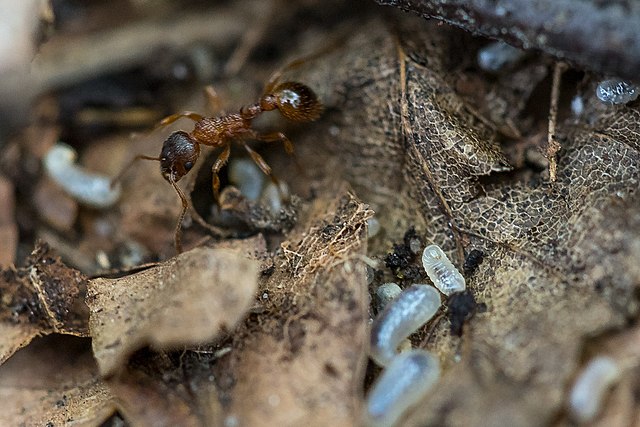Ants translocate their larvae and pupae to a warm bird’s nest
In the nest of a wood warbler not only young wood warblers may grow up, but also ants, as Marta Maziarz and colleagues discovered. Ant larvae and pupae probably survive, grow and develop better in the bird’s nest than in their own nest.
Usually, nests of European forest ants, especially Myrmica ruginodis and Myrmica rubra (the European fire ant or common red ant), are so cold in spring that the larvae and pupae do not grow well. Their development only starts at 16°C, but ant nests rarely get that warm before summer. They are located on the forest floor, between fallen leaves of deciduous trees. The ants cannot produce heat, so without sunlight the nests have the same temperature as the environment. A temperature of 20 to 25°C is optimal for raising brood; the nests never reach that temperature in spring.
But warm places are available nearby, Marta Maziarz and colleagues show. On the forest floor, the wood warbler, a songbird that breeds in European forests, makes a domed nest of grasses, leaves and moss. The bodies of bird parents and, later on, their fully feathered young keep the nest warm.
Translocation
When the bird parents incubate the eggs, in the second half of May, the nest temperature often reaches 16°C or more; especially on cold days, the difference with the ambient temperature is large. Once the young birds are fully feathered, in the first week of June, the nest temperature even rises to 20°C and higher.
This is a nice temperature for the ants, which indeed visit the warm wood warbler’s nest. In cold weather in May and in the first week of June, they move larvae and pupae from their own nest to a bird’s nest and put them in the sidewalls. Translocation is a lot of work, but apparently, it is worth the effort.
After fledging, the vacant nest cools down again. But the ants don’t remove their brood immediately; they delay relocation for up to two weeks. There is no hurry, because the bird’s nest is no longer warm, but it is not colder than the ants’ nest either.
In the primeval forest of Białowieża in Poland, where Maziarz conducted the research, the ants use 10 to 30 percent of wood warblers’ nests as incubators. The birds do not suffer from the inhabitants, but they do not benefit from them either. Therefore, they do not specifically seek the proximity of ant colonies when starting nest building. It is the ants that start the relationship and benefit from it.
Willy van Strien
Photo: Myrmica ruginodis with brood. Jan Anskeit (Wikimedia Commons, Creative Commons CC BY 4.0)
Sources:
Maziarz, M., R.K. Broughton, L.P. Casacci, G. Hebda, I. Maak, G. Trigos‑Peral & M. Witek, 2021. Interspecific attraction between ground‑nesting songbirds and ants: the role of nest‑site selection. Frontiers in Zoology 18: 43. Doi: 10.1186/s12983-021-00429-6
Maziarz, M., R.K. Broughton, L.P. Casacci, A. Dubiec, I. Maák & M. Witek, 2020. Thermal ecosystem engineering by songbirds promotes a symbiotic relationship with ants. Scientific Reports 10: 20330. Doi: 10.1038/s41598-020-77360-z
